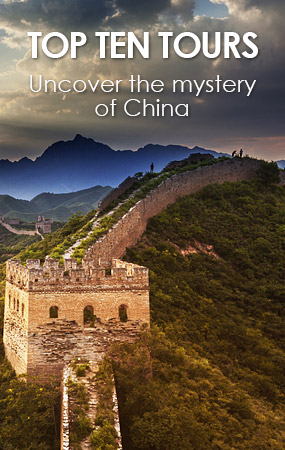Virtual Guide
Since the Forbidden City, 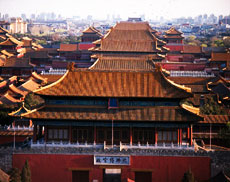 as you know, has more than 9,999 buildings, it is very easy to get lost for one who is not familiar with Chinese architectural layout though it is definitely symmetrical. Now I will take you for a virtual tour around the mysterious palace complex. Follow me and don't get yourself lost!!!
as you know, has more than 9,999 buildings, it is very easy to get lost for one who is not familiar with Chinese architectural layout though it is definitely symmetrical. Now I will take you for a virtual tour around the mysterious palace complex. Follow me and don't get yourself lost!!!
Now start your tour in the Forbidden City from Wumen, called Meridian Gate in English. It is also named Five-PhoenixTower, Wufenglou in Chinese, for it looks like a phoenix with five pavilion buildings up there. It's the main gate and south gate of the Forbidden City. Inside the Meridian Gate, there appear Inner Golden Water Bridges. Water flows beneath these white marble bridges. The GoldenWaterRiver of this section is very gorgeous, well decorated. The riverbed and the bank were paved with white stones. Decorative marble columns and banisters were established along the river. Standing on the bridges, one can see a grand structure called Taihemen (Gate of Supreme Harmony), which is the most marvelous gate in the city and guarded by a couple of bronze lions in front. On the square between Taihemen and Wumen, imperial honor guards proceeded preparation before grand ceremonies.
The three main halls of the outer court, Taihedian (Hall of Supreme Harmony), Zhonghedian (Hall of Central Harmony) and Baohedian (Hall of Preserved Harmony) sit in line inside the gate. These halls all sits on three-tier marble terraces, with marble balustrades decorated. A stone ramp carved with coiled dragons and clouds locates in the middle of the steps leading up to each hall. The ramp of Baohedian (Hall of Preserved Harmony) is the largest one.
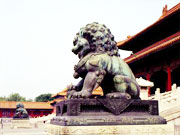 The first and grandest hall is Taihedian (Hall of Supreme Harmony), where emperors executed their autocracy over the whole country. It is the place where emperors ascended the throne and granted formal interviews to officials and important events were celebrated. The hall was flanked by Wenhuadian (Hall of Literary Glory) and Wuyingdian (Hall of Martial Velour). The former, on the right side, used to be the study of the crown princes, where banquets and some rites were held. The latter, on the left side, is the imperial press where many books were compiled and published and where Li Zicheng, the famous peasants uprising leader, ascended his throne after overthrowing the Ming dynasty. On the north of Wenhuadian lies Wenyuange (Pavilion of Literary Source), the imperial library where the world largest encyclopedia Sikuquanshu (Complete Library of the Four Treasures of Knowledge) was housed. The library architecture has many Chinese cultural facts in its structure and decoration. Nanxundian (South Fragrance Hall) near Wuyingdian is where portraits of emperors of dynasties are kept.
The first and grandest hall is Taihedian (Hall of Supreme Harmony), where emperors executed their autocracy over the whole country. It is the place where emperors ascended the throne and granted formal interviews to officials and important events were celebrated. The hall was flanked by Wenhuadian (Hall of Literary Glory) and Wuyingdian (Hall of Martial Velour). The former, on the right side, used to be the study of the crown princes, where banquets and some rites were held. The latter, on the left side, is the imperial press where many books were compiled and published and where Li Zicheng, the famous peasants uprising leader, ascended his throne after overthrowing the Ming dynasty. On the north of Wenhuadian lies Wenyuange (Pavilion of Literary Source), the imperial library where the world largest encyclopedia Sikuquanshu (Complete Library of the Four Treasures of Knowledge) was housed. The library architecture has many Chinese cultural facts in its structure and decoration. Nanxundian (South Fragrance Hall) near Wuyingdian is where portraits of emperors of dynasties are kept.
Behind Taihedian is Zhonghedian (Hall of Central Harmony), a square building much smaller than Taihedian. It was the place where the emperor rested on his way to Taihedian and interviewed his ministers or officials from the Ministry of Rites and rehearsals for ceremonies were also held here.
Baohedian (Hall of Preserved Harmony), the second largest architecture in the palace, is the rear hall of the Outer Court. Imperial banquets were often given here to entertain high officials. Emperors presided the final stage of national examinations to select officials from intellectuals all over the country in this hall.
Getting out of the Baohedian, visitors will see Qianqingmen (Gate of Celestial Purity), which is the boundary of the Outer Court and the Inner Court. Inside the gate, the royal family resides. In the Qing Dynasty, Emperor Kangxi often heard reports from high officials and issued his orders under the gate. The Inner Court is divided into three parts. The three halls on the center axis are the main structures and they are smaller in size than the three halls in the Outer Court, although they look the same in style. Xiliugong (Six Western Palaces) and Dongliugong (Six Eastern Palaces) are also important structure compl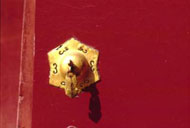 exes, where the emperors' concubines lived.
exes, where the emperors' concubines lived.
The first hall inside the Qianqingmen is Qianqinggong - Palace of Celestial Purity, which was originally the bedroom of emperors as well as their office. Emperors also gave banquets here. Behind it is a smaller hall named Jiaotaidian (Hall of Celestial and Terrestrial Union), where empresses received greetings from others concubines. It was used to store emperor and empress's imperial seals. The third hall on the central axis is Kunninggong (Palace of Terrestrial Tranquility), which was empress' bedroom.
On the left side of the Inner Court, Yangxindian (Hall of Mental Cultivation) and Xiliugong (Six Western Palaces) stand from north to south . Yangxindian (Hall of Mental Cultivation) was an important hall in the palace since from Emperor Yongzheng, most emperors later lived and attended to state affairs here. North of Yangxindian, there locates Xiliugong (Six Western Palaces), which consists of Yongshougong (Palace of Eternal Longevity), Yikungong (Palace of the Queen Consort), Chuxiugong (Palace for Gathering Elegance), Taijidian (Hall of the Supreme Pole), Changchungong (Palace of Eternal Spring) and Xianfugong (Palace of Universal Happiness). The former three are on the right and the latter three on the left of an alley which goes from north to south.
On the right side of the Outer Court, viz. east side, there are Fengxiandian (Hall for Ancestral Worship), Zhaigong (Palace of Abstinence) where emperors practiced abstinence a few days before going to offer sacrifices at the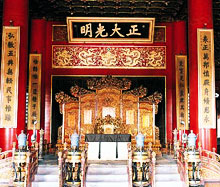 Temple of Heaven or the Temple of Earth, and Dongliugong (Six Eastern Palaces) which consists of Jingrengong (Palace of Great Benevolence), Chengqiangong (Palace of Celestial Favour), Yonghegong (Palace of Eternal Harmony), Jingyanggong (Palace of Great Brilliance), Zhongcuigong (Palace of Purity) and Yanxigong (Palace of Lasting Happiness). In a separate enclosure further east are two palaces which Emperor Qianlong built for his abdication. They are Ningshougong (Palace of Tranquil Longevity) and Huangjidian (Hall of Imperial Supremacy). Further north, there are Yangxingdian (Hall of Temper Cultivation), Leshoutang (Hall of Joyful Longevity) and Yihexuan (Pavilion of Sustained Harmony). Now most these palaces on the east are exhibition halls displaying different curiosities.
Temple of Heaven or the Temple of Earth, and Dongliugong (Six Eastern Palaces) which consists of Jingrengong (Palace of Great Benevolence), Chengqiangong (Palace of Celestial Favour), Yonghegong (Palace of Eternal Harmony), Jingyanggong (Palace of Great Brilliance), Zhongcuigong (Palace of Purity) and Yanxigong (Palace of Lasting Happiness). In a separate enclosure further east are two palaces which Emperor Qianlong built for his abdication. They are Ningshougong (Palace of Tranquil Longevity) and Huangjidian (Hall of Imperial Supremacy). Further north, there are Yangxingdian (Hall of Temper Cultivation), Leshoutang (Hall of Joyful Longevity) and Yihexuan (Pavilion of Sustained Harmony). Now most these palaces on the east are exhibition halls displaying different curiosities.
North of the Inner Court is Yuhuayuan (Imperial Garden). Though small in size, it is exquisitely laid out with towers, pavilions, artificial hills, springs, rocks, old trees, flowers and lawns - a replica of the gardens of southern China.
Just behind the garden is Shenwumen (Gate of Divine Might), the rear gate of the Forbidden City. On the gate there were a drum and a bell. The bell used to toll 108 times to announce a new day while the drum rataplaned the time in the night.
Can you find the way? And are you impressed by the grandness and magnificence of the world largest palace structure?
Now start your tour in the Forbidden City from Wumen (Meridian Gate).

